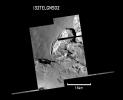
|
Slumping Cliff on Io in High Resolution
- Click the image above for a larger view
- Full-Res JPEG (798 x 401) (41.9 kB)
- Full-Res TIFF (798 x 401) (309.9 kB)
Caption:
A cliff slumps outward in these high-resolution views that NASA's Galileo spacecraft captured the edge of a mountain named Telegonus Mensa on Jupiter's moon Io.
When Galileo flew near the south pole of Io in October 2001, scientist's targeted this cliff to study the process of erosion. Water and wind cause most erosion on Earth, but Io has neither surface water nor an atmosphere. The cliff is slumping due to gravity.
The smaller picture (top) has a resolution of 10 meters (33 feet) per picture element. Galileo's camera took it from a distance of about 1,000 kilometers (620 miles). The larger image (below) sets context with a resolution of 40 meters (131 feet) per picture element and was taken from a distance of about 4,200 kilometers (2,600 miles). North is to the top and the Sun illuminates the surface from the upper right.
|
Background Info:
The Jet Propulsion Laboratory, a division of the California Institute of Technology in Pasadena, manages the Galileo mission for NASA's Office of Space Science, Washington, D.C. Additional information about Galileo and its discoveries is available on the Galileo mission home page at http://galileo.jpl.nasa.gov/ . Background information and educational context for the images can be found at http://solarsystem.nasa.gov/galileo/gallery/io.cfm .
Cataloging Keywords:
| Name | Value | Additional Values |
|---|---|---|
| Target | Io | |
| System | Jupiter | |
| Target Type | Satellite | |
| Mission | Galileo | |
| Instrument Host | Galileo Orbiter | |
| Host Type | Orbiter | |
| Instrument | Solid-State Imaging (SSI) | |
| Detector | ||
| Extra Keywords | Atmosphere, Grayscale, Mountain, Water | |
| Acquisition Date | ||
| Release Date | 2001-11-27 | |
| Date in Caption | ||
| Image Credit | NASA/JPL/University of Arizona | |
| Source | photojournal.jpl.nasa.gov/catalog/PIA02597 | |
| Identifier | PIA02597 | |

